Trine 3: The Artifacts of Power takes the series’ familiar linear puzzle-platforming mechanics and fantasy setting and reimagines them in fully three dimensional environments. Following their adventures to save multiple kingdoms in the first two Trine videogames, Pontius the Knight, Zoya the Thief, and Amadeus the Wizard have gone their separate ways. Their hardfought independence is interrupted with the return of the Trine, the Artifact of Soul, which once more entangles their souls into one and transports them to a land in need of their help. The heroes, frustrated at being toyed with yet again by the Trine, reject the artifact and try to return its power. This causes the Trine to shatter and release the seal on an evil spirit named Sarek the Deathless. Regretting their mistake, the heroes reluctantly team up to utilize their distinct skills to complete another adventure. In order to defeat Sarek, they must not only repair the shattered Trine, but also reunite the Artifact of Soul with the Artifact of Body and the Artifact of Mind: The Artifacts of Power.
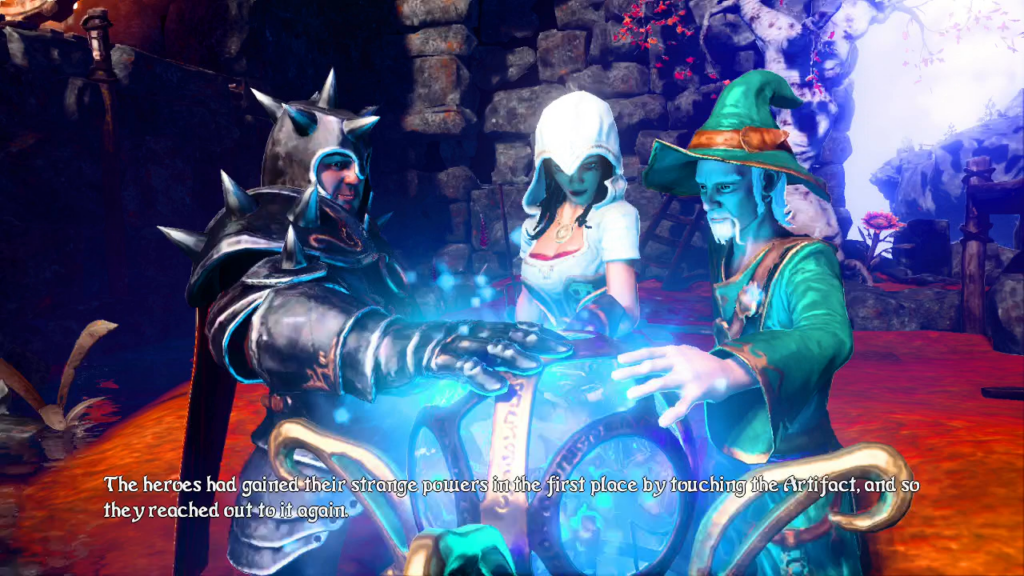
The biggest change both visually and mechanically Trine 3 brings to the series is its fully three-dimensional level design. Instead of restricting the heroes to moving only to the left and right, they are able to run in broader environments that stretch in all directions. Despite this expansion, it’s not a complete reimagination of what came before. The camera remains fixed at specific angles, sometimes panning to the left or right as the heroes move across the screen, and sometimes following them as they move away from or towards the frame. This adds a new dimension of movement to the levels while keeping them linear, preserving the series’ fundamental design ethos.
Trine 3’s puzzle-platforming premise is unchanged from its predecessors. Pontius the Knight, Zoya the Thief, and Amadeus the Wizard have their souls entangled by the Trine and become a single physical entity. Their collective body magically reshapes itself into the form of the hero that presently controls it. My role as the player is to freely swap between the trio, leveraging their unique abilities off each other and off the environment to solve platforming puzzles that bar their way forward.
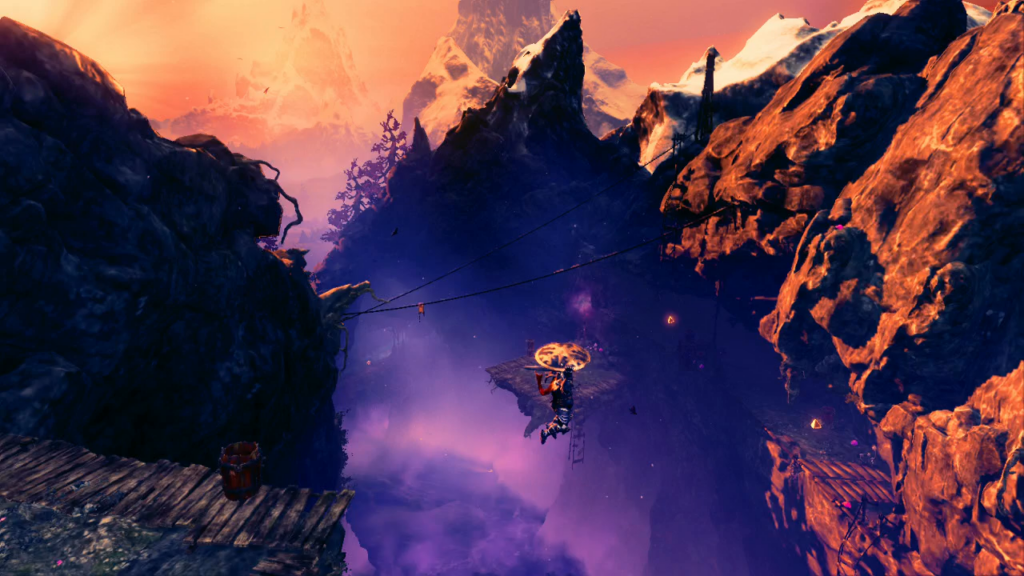
What does feel dramatically changed is the power and flexibility of each hero’s individual abilities. Pontius was always the most dubiously useful of the trio in puzzle-platforming scenarios. He maintains his chief utility, that by hoisting his shield over his head he may glide long distances in what can only be a magical defiance of physics. Because Trine 3’s environments are so much larger than Trine 1 and 2’s, this ability gets a lot more use, improving his gliding ability from questionably useful to situationally useful. Amadeus feels like he is hit hardest by a power reduction; he’s still an incompetent wizard who can only levitate objects and create clockwork boxes, but instead of being able to conjure entire towers of boxes, he can now summon a single box into existence. If he creates another, the current box disappears in a flash of light.
It’s in Zoya’s abilities where it feels like refinement has led to the most impactful changes to Trine’s original puzzle design. She can still fasten a rope to surfaces by tossing a grappling hook, but instead of sticking to any wooden surface the hook now attaches to prefixed metal rings. This has tradeoffs. The number of surfaces the rope may stick to is greatly reduced, but it may now be used for much more than swinging and climbing. By attaching both ends of the rope to a pair of rings, Zoya can add a new component to a mechanism in the environment. Conversely, she can also bring a mechanism to a halt by tying it to a block or pillar. Most of Trine 3’s smartest puzzles involve Zoya’s rope and grappling hook.
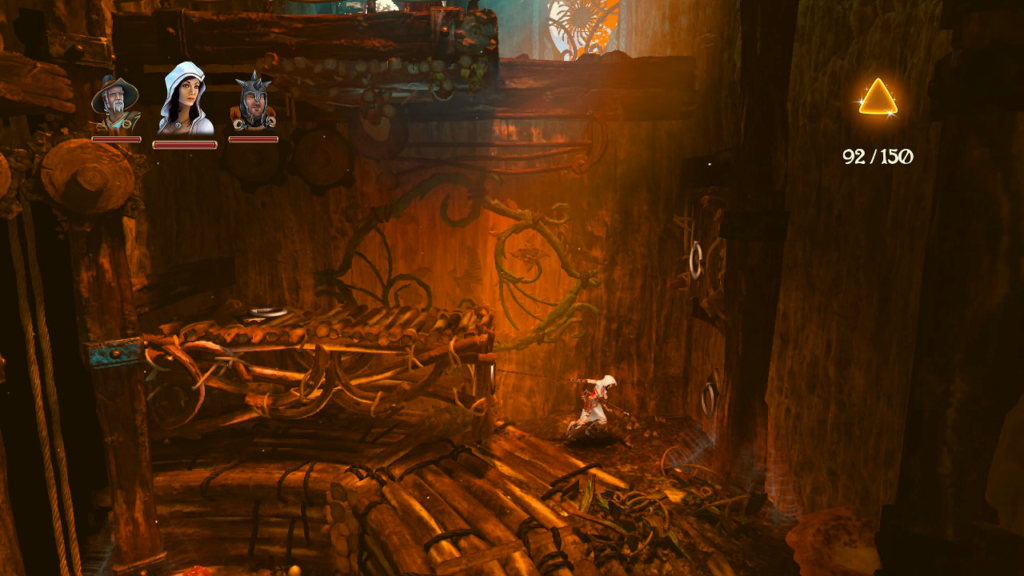
Trine 1 and 2 were heavily built around their physics engine. Weight felt like an important part of every puzzle. In Trine 3, physics feel less important. This may be a result of them feeling more developed and refined. There are fewer situations where objects are flung at comical speeds by a small movement. Monsters no longer collapse as though their bodies change from feather-light to lead weights when they are defeated. Zoya can no longer impossibly fling herself onto the tops of platforms she dangles from. The weight and momentum of everything the heroes touch seem much more natural. This also makes the experience feel less unique. Trine 1 and 2 are notable for their ridiculous and memorable physics. Trine 3’s physics are barely notable at all.
Judged on their own merits, these changes to familiar abilities are not much of a problem. The puzzles are still satisfying to solve, if simple and straightforward. When stacked against the previous two Trine videogames, the reduced puzzle solving freedom is a disappointment. The wild improvisational solutions allowed by the heroes’ abilities and the unwieldy physics in Trine and Trine 2 simply aren’t possible in Trine 3. Most puzzles feel like they have one obvious intended solution. Part of me is glad to not be tempted to bypass almost every obstacle by conjuring a tower of boxes with Amadeus. Another part of me resents that this choice has been taken away.
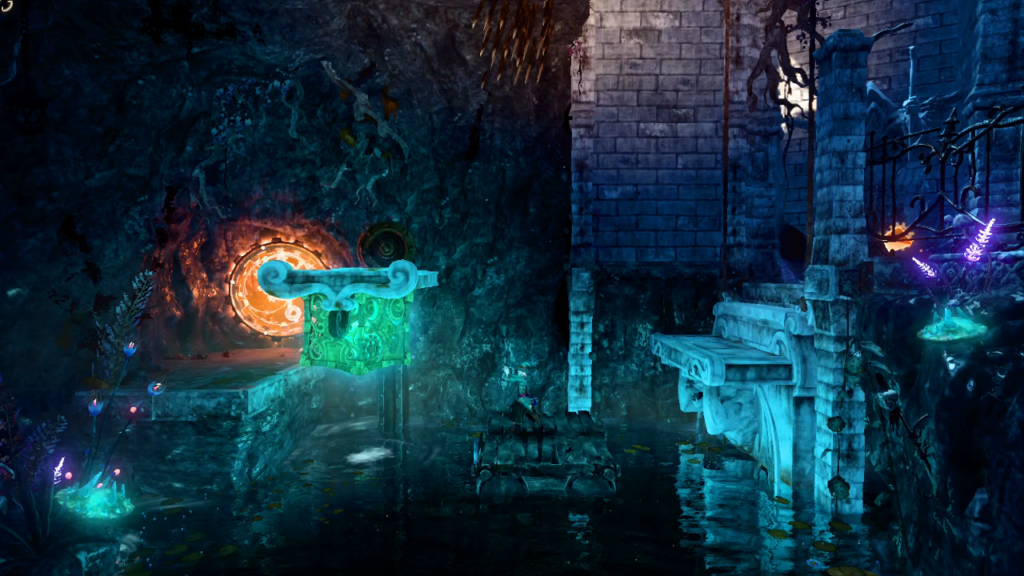
Less refinement is brought to the combat. Pontius is still the trio’s combat work horse. Whenever a monster appears on screen, Pontius is the primary choice. His ability to block any attack with his shield and respond with swings from his sword is invaluable in almost any combat situation. But since he can now be attacked from all sides and not just from the front and back, blocking these attacks is more difficult when he becomes surrounded.
Zoya’s new performance in three dimensions is more mixed. She still wields a bow and arrow in combat, allowing her to plug enemies from afar, but I must rely on the videogame to determine the angle she fires her arrows at. If an enemy or other target is on higher ground than Zoya, I have to trust the line representing the path of her arrow will automatically arch upward to target them. It’s a twin-stick shooting system applied to a fully three-dimensional environment and it never feels natural.
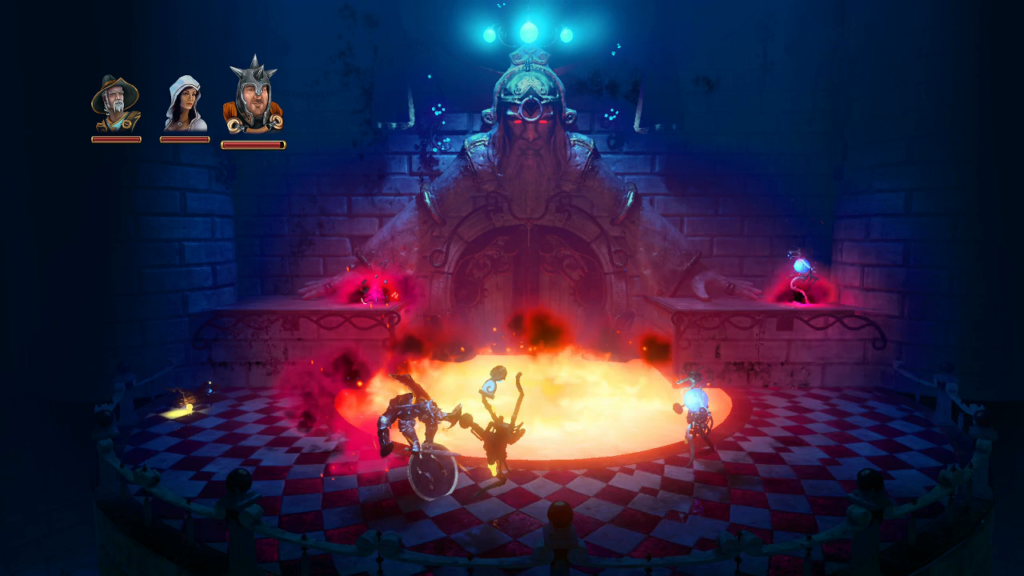
In my reviews of both previous Trine videogames, I lamented Amadeus’ limited use in combat. Trine 3 finally answers my criticism by letting the Wizard slam his conjured boxes down on enemy heads. This is incredibly damaging and powerful, but keeping Amadeus free from harm while also trying to maneuver a box over an enemy’s head can prove tricky.
When Amadeus or one of his companions does inevitably die in combat, it presents a different situation than I had to deal with previously. Instead of remaining permanently inaccessible until getting a game over or reaching the next checkpoint, a fallen hero appears as a spirit near where they died. Standing near the spirit for a few seconds causes them to regenerate. This side steps some of the clumsier design that came before. In Trine 1 and 2, heroes were functionally invincible while standing in front of a checkpoint, which was often. Trine 3 makes me put a little more effort into recovering a fallen hero while also allowing for a more flexible strategy than retreating to a checkpoint.
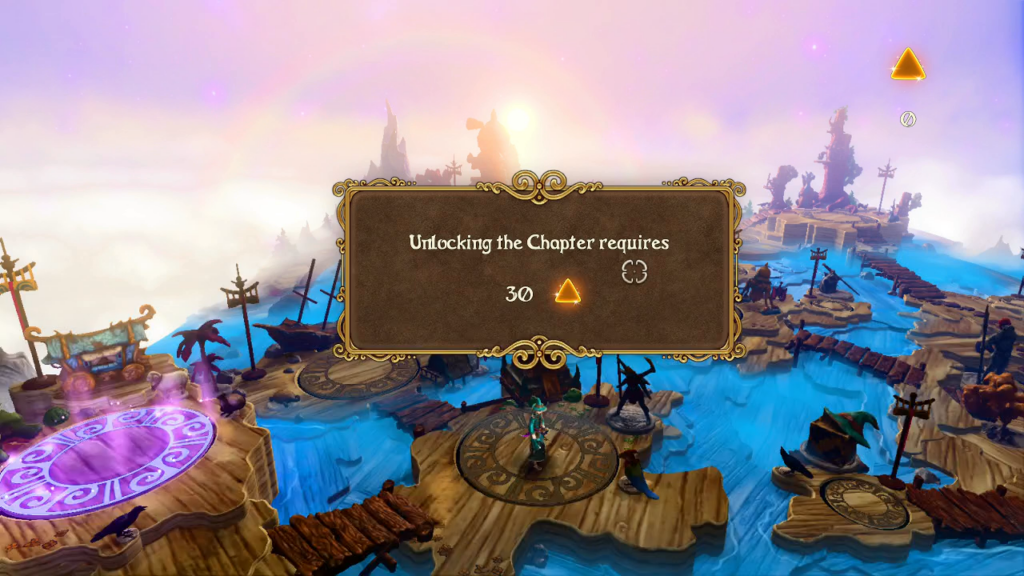
Levels are selected from a world map which is artfully built on top of an open book the heroes visit between each mission. To open a new chapter in the story, all the chapters preceding it must be finished and the heroes must also possess a certain number of Trineangles.
Trineangles are shining golden pyramids strewn across every open space in every chapter. Collecting them feels nominal; the amount needed to open new chapters is so trivial that I have to practically ignore them to come up short. They’re a shallow unlock mechanic. At the same time the levels would feel emptier without their presence and they give me something to work towards for one hundred percent completion.
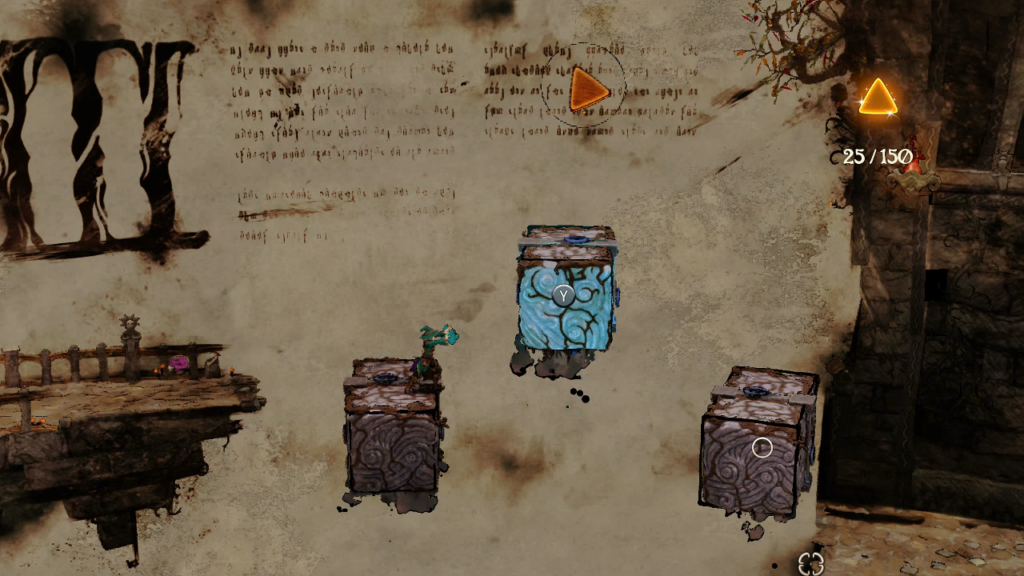
Level variety is spectacular. The heroes’ journey finds them traveling through a cliffside fortress, a snowy wooded mountaintop, and a mysterious Arcane Academy so thick with magical power it exudes into the air as a thick purple mist. The best chapter thoughtfully exposits the Artifacts of Powers’ backstory by literally sucking the heroes inside the book that describes them. This chapter renders the environment and characters with thicker lines and starker colors, as though they have become illustrations in a musty tome. It’s visually superior to the rest of Trine 3’s colorful but muddled and dark palette.
In another break from Trine 1 and 2, not every chapter in Trine 3 is part of the core progression. Alongside the main chapters on the world map are smaller circles representing mini-levels. These levels offer specialized obstacles courses designed to be completed with just one of the heroes. They generally fill in some of that hero’s backstory, portraying an adventure that hero had before they were summoned by the Trine. Only Zoya’s pursuit of a giant jewel has any kind of interest.
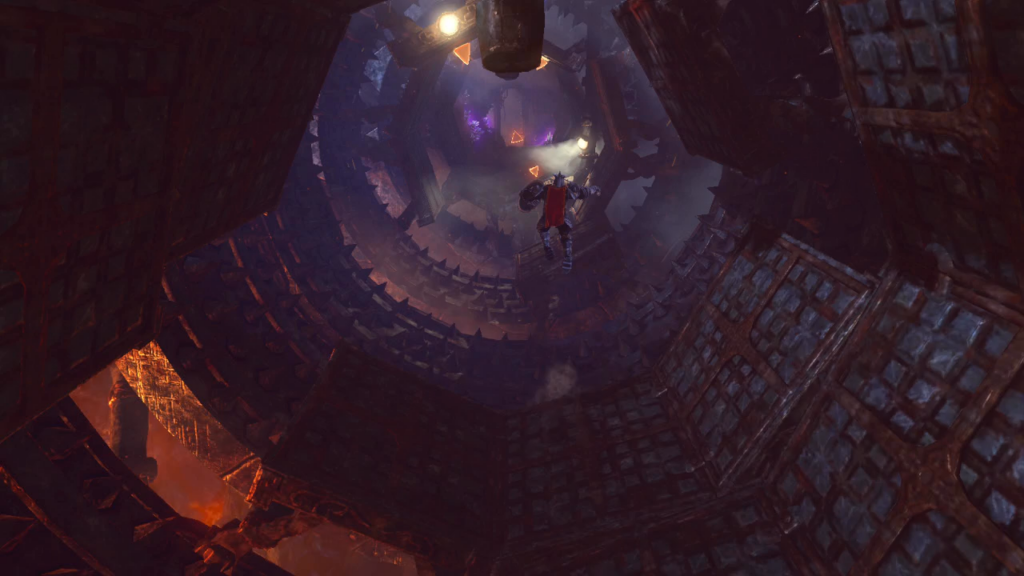
Most mini-levels are puzzle focused. Since they only allow the use of a single hero, these puzzles are simpler and easier than those found in the story missions that utilize all three characters’ skills. A handful of mini-levels are combat-focus gauntlets against multiple waves of enemies. These are the toughest challenges in Trine 3 since they must be completed with a single character in a single life. One gauntlet that must be completed with Amadeus the Wizard is particularly memorable if only for how unexpected and unorthodox it is.
Mini-levels surprisingly outnumber the story levels. This is counterbalanced by how short they are. Most can be completed in only a few minutes and only have a few dozen Trineangles to recover. They’re a nice addition which do much to pad Trine 3’s runtime and to further trivialize the need for Trineangles to unlock story chapters, but none of them feel memorable. They’re a dispensable part of the design replete with puzzles that would have been better if they were integrated into proper, full-length chapters.
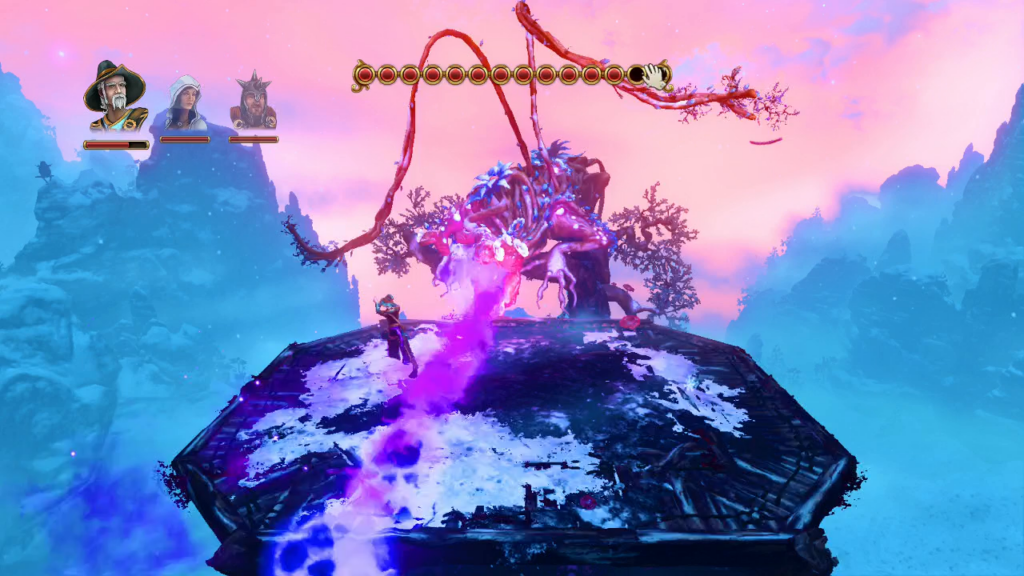
Trine 3’s real trouble is it’s an unfinished videogame. This is not a hyperbolic statement. I don’t mean it feels unfinished, that I am inferring from my dissatisfaction with its narrative or design elements that essential parts of the plot or mechanics are missing. I mean that after the heroes clear the map of its story levels and defeat the boss that capstones them, they triumphantly announce that “the Artifact of Soul will be restored in no time.” The heroes set out for the Giantlands to search for the next Trine shard, the credits play, and Trine 3: The Artifacts of Power is over. The heroes never reassemble the Trine and never confront Serak the Deathless. It is an unfinished videogame.
Knowing that Trine 3 is unfinished fills me with questions. The heroes’ abilities feel limited, but knowing that this is only the first quarter of a hypothetically much longer videogame, might they have learned new abilities or expanded their current ones as they progressed? The gamepad controls make it difficult to target specific monsters or objects with Zoya’s and Amadeus’ abilities in the three dimensional environment; would this system have been more refined in a completed product? At times the player characters go haywire, hanging from a ledge one second and then bouncing across the screen in the next, becoming completely uncontrollable until they eventually fall off a cliff and die. Would this recurrent bug have been fixed?
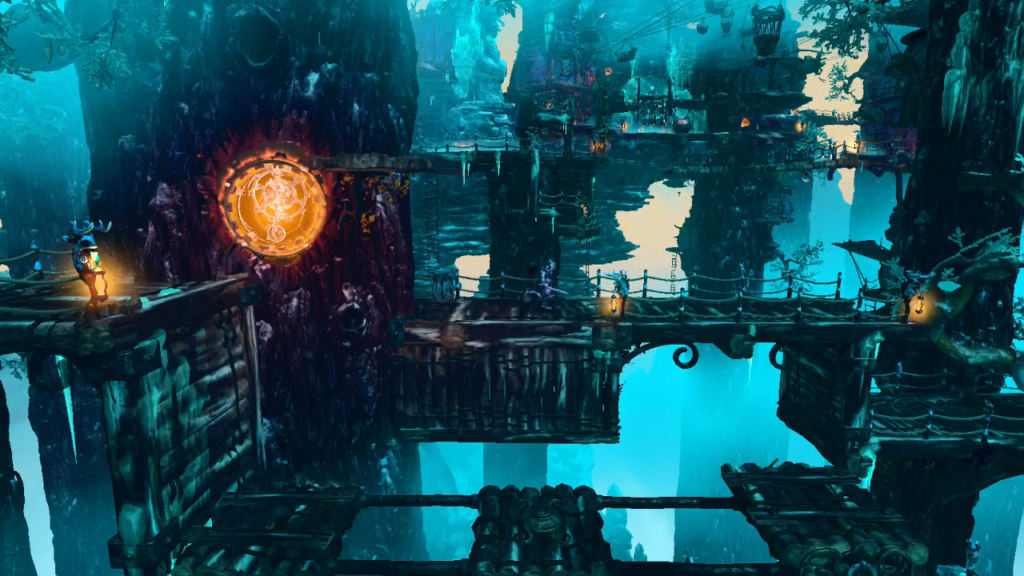
Apparently Trine 3’s unfinished nature came down to project scope and budget. Evolving the first installments’ two dimensional puzzle-platforming design into three dimensions proved more expensive than the developers anticipated. Despite having more than twice the budget of Trine 2, they found that completing Trine 3 would have required at least eight times its budget. This is unfortunate. What’s here shows a lot of promise.
I can forgive Trine 3 for the realities of its difficult development process and its resultant shortcomings. I can admire it for being a relic of ambition confronted by limitation. I cannot ignore how deceptive its storefront packaging feels. It is not sold as “Trine 3: Part One of Four” or “Trine 3: An Unfinished Adventure.” It is “Trine 3: The Artifacts of Power,” sitting proudly and fraudulently alongside every other Trine installment as though it is equally complete. Despite costing more than the first two Trine installments—$21.99 on Steam at the time of this writing, compared to $14.99 for Trine 1 and $19.99 for Trine 2—Trine 3’s store pages on various storefronts do not trouble themselves with informing its purchaser they are looking at an incomplete product. This alone is damning.
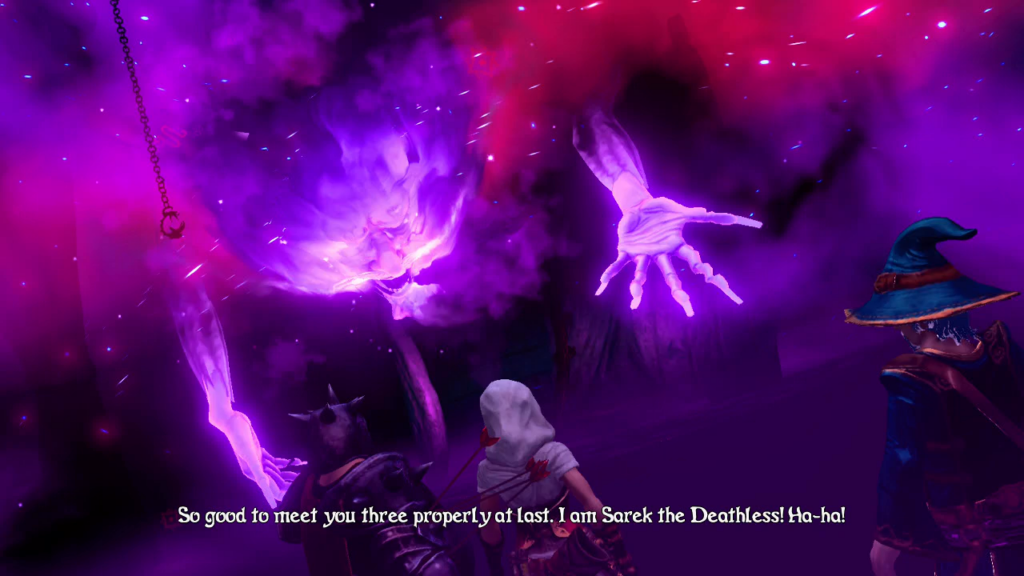
Recommending or not recommending Trine 3: The Artifacts of Power is pointless. It’s an unfinished videogame. Its mechanics feel limited in scope, because they were probably intended to become grander over time. Its narrative encompasses about one third or one quarter of the story it wants to tell, coming to an abrupt halt on a cliffhanger that will never be resolved. Worst of all, it is not marketed as an unfinished videogame. If someone purchased it without reading a review like this one first, there’s no reasonable way they could know.
None of this means that Trine 3 is not an interesting videogame. It’s a rare commercially available example of a videogame frozen in mid-development. By playing it I can see both the evolution from the two videogames that preceded it and also the building-in-progress that might someday have been built into a beautiful and impressive tower. If anybody might find some value here, it would be a videogame developer looking to gain insight into the development process of both a series and an individual videogame. For everyone else, get Trine 3 as part of a Trine series bundle, or don’t bother at all.